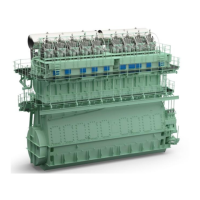Operation0620−1/A1
Winterthur Gas & Diesel Ltd.
2/ 3
8) Close the stop valves on the fuel tanks.
9) Open the drain valves of the exhaust gas manifold and the exhaust gas pipe to
drain the condensate.
10) Close the drain valves of the exhaust gas manifold and the exhaust gas pipe.
11) Put a cover (e.g. a tarpaulin) on the exhaust gas manifold and the turbocharger
silencer to make an airtight seal. This will prevent air flow through the engine and
thus condensation.
12) For the scavenge air coolers, see the recommended procedures in the
documentation of the manufacturer. If this is not available, we recommend that
the coolers are completely drained or the cooling water pump operated daily for
approximately 30 minutes (with the flow quantity control valves in the same
position as for usual operation conditions).
13) Keep cylinder cooling water approximately at room temperature. Monitor the
temperature for a risk of frost.
14) Repair all the damage and leaks found during the operation period before and
the checks made after shut-down.
15) Do all scheduled overhauls and obey the general guidelines for maintenance
(see the Maintenance Manual 0011−1 and 0012−1).
16) Where the auxiliary engines and boilers are also put out of operation and there is
risk of frost, completely drain all of the cooling systems (in such conditions,
protect the drained systems from corrosion).
17) In the power supply box E85, set to off the circuit breaker to disconnect electrical
power to the WECS−9520.
18) Set to off the control box for the automatic filter.
19) In less than 48 hours after you have put the engine out of service, do the checks
that follow:
a) Open cover on rail unit and look for signs of condensation and corrosion.
b) Remove the inspection cover from supply unit and look for signs of
condensation and corrosion on the internal housing, camshaft, cams and
roller.
Prepare the Engine for a Long Shutdown Period
2017−08

